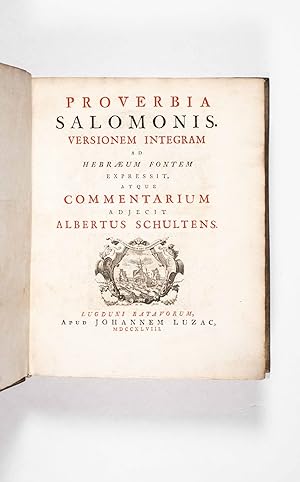bible latin (41 Ergebnisse)
Produktart
- Alle Produktarten
- Bücher (41)
- Magazine & Zeitschriften
- Comics
- Noten
- Kunst, Grafik & Poster
- Fotografien
- Karten
-
Manuskripte &
Papierantiquitäten
Zustand
- Alle
- Neu
- Antiquarisch/Gebraucht
Einband
- alle Einbände
- Hardcover (14)
- Softcover
Weitere Eigenschaften
- Erstausgabe (5)
- Signiert (1)
- Schutzumschlag
- Angebotsfoto (30)
Land des Verkäufers
Verkäuferbewertung
-
Decorated antiphonary choirbook leaf.
Verlag: 15th or 16th century, Germany?
Anbieter: Rodger Friedman Rare Book Studio, ABAA, Tuxedo, NY, USA
Zustand: Good. Manuscript leaf on vellum, 290 x 400mm. Eight staves and eight lines of text on recto and verso. Seven elaborate polychrome decorated letters in blue, black, green, and gold. Text in black with rubrication, staves in red. Old inscription in upper margin of recto, old pencil notes in lower margin. Single leaf extracted from an antiphonary. Main text is from Isaiah, 55. Remarkable decorated initials in Gothic style.
-
Biblia Sacrosancta ad Hebraicam veritatem, & probatissimorum ac manuscriptorum exemplarium fidem diligenter recognita & restituta
Verlag: Nicolaum Bryling [Nicolaus Brylinger], Basilaea [Basel], 1557
Anbieter: James Cummins Bookseller, ABAA, New York, NY, USA
Woodcut border and printer's device on title. INCOMPLETE. [8], 479 [of 500], [8] leaves. Lacking ff. 46-56 & 61-70. 1 vols. 8vo. Brylinger published the only 16th century edition of Luther's Bible in Switzerland, published one of the earliest Greek and Latin diglot Bibles, and published a series of 8vo editions of the Bible with diglot and Greek-only text which was popular with students. Darlow & Moule makes no mention of this or any other Latin-only edition by Brylinger. Front paste-down endpaper and front free endpaper display extensive annotations in Greek and Latin, presumably by Johannes Weneken. The marginal annotations provide a fascinating insight into how this book was used. Not in Darlow & Moule, but cf. 4621*; Adams 1056; OCLC: 46973017 (6 copies, only 3 of which in U.S.) Bound in contemporary blind panel-stamped pigskin over bevelled wooden boards, clasps removed, binding worn, exposing boards on rear cover, title page detached, contemporary marginalia by Johannes Weneken throughout Woodcut border and printer's device on title. INCOMPLETE. [8], 479 [of 500], [8] leaves. Lacking ff. 46-56 & 61-70. 1 vols. 8vo.
-
Biblia Sacra utriusque Testamenti, iuxta Hebraicam et Graecam ueritatem, uetustissimorumq[ue] ac emendatissimorum codicum fidem diligentissime recognita
Verlag: Petrus Quentel excudebat, Coloniae, 1527
Anbieter: James Cummins Bookseller, ABAA, New York, NY, USA
First Protestant Bible printed in Latin. First Protestant Bible printed in Latin. Title-page with large woodcut vignette of arms of Cologne, lion and gryphon rampant with and three crowns; numerous illustrations by Anton Woensam and ornamental initials throughout. Ff. [8], CCCXXV, [1], LXXXVII (i.e. 85), [5]. 1 vols. Folio. Cologne, 1527 : Quentel's Protestant Bible in Latin. The first Protestant Bible in Latin, edited by Johan Rüdel (Rudelius), printed in Cologne by Peter Quentel (or Quentell), and notable for the wood engraved illustrations by Anton Woensam (Anton von Worms), particularly those at the head of each of the four gospels. Matthew faces an angle who is touching his stylus; a lion is seated beside Mark; a bull with Luke; and an eagle stands beside John. Quentel was the printer of Tyndale's quarto Cologne English New Testament, known from a single surviving fragment in the Grenville Collection, where this same illustration to Matthew appears. It is a reasonable inference that each of the four gospels would have carried an illustration. The project, which had "'got as far as the letter K', the signature that would have taken the work well into Mark" (ODNB) was unfinished at the time of Tyndale's flight from Cologne in 1525. Quentel's print shop was raided, but sheets of the first gospel translated from the original Greek and printed in English soon began to circulate in England. Tyndale settled in Worms, where Schöffer completed an octavo printing of the first complete English New Testament in 1526 (a facsimile of the Grenville fragment and its illustration were published in 1871). The blocks for the illustrations evidently survived the raid on the Quentel's shop, and are used here at the head of each of the four gospels. A notable edition in the history of the printing of the Bible. Adams 1007; not in Darlow & Moule but see note to 6107; VD16 B2589.OCLC: 22847218 Recent half calf and marbled boards. Title page soiled, old remargining, tissue repairs on verso; some marginal worming and soiling, generally clean, with generous margins. Stamps of Cambridge Public Library in ink or in blind on four leaves Title-page with large woodcut vignette of arms of Cologne, lion and gryphon rampant with and three crowns; numerous illustrations by Anton Woensam and ornamental initials throughout. Ff. [8], CCCXXV, [1], LXXXVII (i.e. 85), [5]. 1 vols. Folio.
-
Biblia sacra vulgatae editionis, Sixti V. Pont. M. jussu recognita, et Clementis VIII. Auctoritate edita.
Anbieter: Kloof Booksellers & Scientia Verlag, Amsterdam, Niederlande
Zustand: very good. Auctoritate edita. Coloniæ Agrippinæ : sumpt. Hæred. Balthasaris ab Egmond, & Sociorum , 1743. Contemp. calf binding. [24], 894, [43] pp. 17x11 cm. With engraved title-page. Library stamps on free endpapers. Binding shows some wear. Very good copy. - 4 copies in NCC (Amsterdam (2), Naastricht & Nijmegen). Condition : very good copy. Keywords : , Bible.
-
Decorated leaf from a Book of Hours Manuscript on vellum.
Verlag: ca 1550, 1550
Anbieter: Rodger Friedman Rare Book Studio, ABAA, Tuxedo, NY, USA
One vellum leaf, 125 x 180 mm, with text within 80 x 95 mm guidelines. Text in manuscript recto and verso including eight capitals decorated in gold leaf and colors, and six spacers also decorated in blue, red, and gold leaf. Chapter incipit in red.
-
Biblia sacra, vulgatae editionis . Pars Prima [- Altera] autore J.B. Duhamel.Editio secunda accuratissima, ad exemplaria Vaticana fideliter recognita, .
Anbieter: Kloof Booksellers & Scientia Verlag, Amsterdam, Niederlande
Erstausgabe
Zustand: very good. Lovanii (Louvain): Martinus van Overbeke, 1740; Complete in 2 volumes: I: (24), xxi, (1), 520 pp.; II: 506, 44 (index geographicus; tabulae chronologiae sacrae) pp. Contemporary calf with raised bands and gilt decorated spine, edges red, marbled endpapers. Folio 29x48 cm. Margins wide. Our copy lacks the plate with biblical scenes but has in volume I: full page frontispiece portrait of the dedicatee Thomas-Philippe de Hennin-Liétard Archbishop of Malines after Ae. J. Smeyers by Pieter Tanjé, printer's mark on titlepage, 1 smaller engraving after L.F.D.B. also by Tanjé, 2 folding maps (totius orbis; terra promissa), 1 map on 2 pages (Terre Saint O.T.); In Volume II: printer's mark on titlepage, 1 map (Terre comme lorsque l'Évangile fut publié). 2 Maps after Nicolas Sanson d' Abbeville. The pp. of volume I 499-506 contain an "index epistolarum et evangeliorum quae e veteri et novo testamento excerpta", "index testimoniorum a christo", "Hebraicorum, chaldaeorum, graecorumque nominum interpretatio". Text in Latin. Very good copy of this second Belgian printing of the Vulgate edition of the Bible commentated by J.B. Duhamel (1624-1706). The first edition had appeared in Paris 1705. With all maps and engraved full page frontispiece but lacking 1 plate. Bindings with moderate worn, mainly at edges and corners, small hole in 1 label at spine; small library stamp on first fly leaves; some occasional browning else very good, solid and clean. Brunet, c. 880 ("notes estimées"); Renier, La Bible imprimée dans les collections de l'Université de Mons-Hainaut XVe-XXe siècle. 1995, n° 50-51; Not in Bibliotheca Belgica. Not in Darlow-Moule. Condition : very good copy. Keywords : ,
-
Biblia sacra [the Gutenberg Bible].
Verlag: Pageant Books, Paterson and New York, 1961
Anbieter: Rodger Friedman Rare Book Studio, ABAA, Tuxedo, NY, USA
Zustand: Fine. 2 volumes folio (48 cm in slipcase). Facsimile printed on rag paper produced for this edition; all pages lithographed, and illuminated pages printed "by sheet-fed gravure." Bound by hand in sturdy full morocco, stamped with Gutenberg's initials on upper boards, titled in gilt on spine. All edges gilt. Marbled endleaves. Protected in original clamshell boxes. Some tenderness to inner hinges of boxes, else about fine. Extra shipping charges will apply at cost. Colophon: "The first Gutenberg facsimile ever printed in the United States and only the second in the world. The reproduction derives from the Insel Verlag edition [1913-14] which was based on the copy in the Koniglichen Bibliothek in Berlin and the copy in the Standischen Landesbibliothek in Fulda, considered by authorities to be the most beautifully illuminated of the 47 copies known to exist . Limited to 1000 numbered sets . [This is] no. 172."/ Printed in black and red. Rubricated in red. Initials and running titles in red and blue (most of the initials floriated or decorated with faces, animals, etc.) Many large initials illuminated in gold (one also in silver) and decorated in many colors (mostly with floral designs, but also with miniatures, birds, etc.), the decoration often filling one or more whole margins of the page." Facsimile edition, limited to 1000 copies, of which this is #79.
-
BIBLIA, AD VETUSTISSIMA EXEMPLARIA NUNC RECENS CASTIGATA
Verlag: Hieronymus Polus, Venetiis [Venice], 1587
Anbieter: Phillip J. Pirages Rare Books (ABAA), McMinnville, OR, USA
213 x 146 mm. (8 3/8 x 5 5/8"). 12 p.l., 1126 pp. ESPECIALLY PLEASING CONTEMPORARY CALF, covers with gilt French fillet frame and oval wreath of olive branches, the center of the wreath in the shape of a cross, flat spine ruled in gilt, red morocco label. Title page with elaborate wood-engraved frame, text profusely illustrated WITH 600 WOOD ENGRAVINGS depicting scenes from scripture, after Holbein, Bernard Salomon (le Petit Bernard), and others (a handful of these a bit indistinct). Front pastedown with ex-libris of Leonis S. Olschki. Adams B-1093; STC Italian 93. Not in Darlow & Moule. â A little wear to joints and extremities, spine a bit crackled, separation at hinges (but no looseness), occasional minor browning or foxing, otherwise in remarkably fine condition, the text clean and crisp, and in a still-lustrous, entirely solid, unsophisticated original binding. This is a very well-preserved, handsomely bound, and lavishly illustrated edition, with distinguished provenance, of the Louvain Bible, first printed in Venice in 1578. Our edition contains 600 wood engravings illustrating the text, ranging from portraits of prophets, saints, and evangelists to dramatic scenes from the histories of the Old Testament and the life of Christ, and ending with an imaginative Apocalypse cycle. Many of these are the work of Lyonnaise artist Bernard Salomon (1506-61), known by the sobriquet "Le Petit Bernard" for his small engravings rich with detail. Others are based on the biblical woodcuts of Hans Holbein. The binding here is likely French; the flat spine with just one large gilt-framed panel and the olive branch decoration on the covers is characteristic of late 16th century and early 17th century French work. The exceptional condition here is typical of books from the collection of Leo Samuel Olschki (1861-1940), scion of a family of Prussian Jewish printers, whose interest in printing history led to his becoming a celebrated antiquarian bookseller, author, founder of the journal "The Bibliophile," and publisher of works in the humanities.
-
Textus Biblie
Verlag: Per Johanem Crespin, Lyons, 1529
Anbieter: Heritage Book Shop, ABAA, Beverly Hills, CA, USA
BIBLE IN LATIN (illustrator). Lyons: Per Johanem Crespin], 1529. Second Crespin edition, reprinted from the 1527 edition. Folio (13 15/16 x 10 inches; 354 x 252 mm.). 304 leaves ([18], CCLXVIII, [18] leaves). Complete with final blank leaf. Gothic type. Text in double columns within rule borders. Title printed in red and black with small woodcut of St. Jerome (repeated three times in the text with Jerome's prefaces) within a four-part woodcut border showing God the Father and two angels in a tympanum, the six days of Creation, and the Last Supper. Large six-part Creation woodcut at the beginning of Genesis, half-page woodcut of King Solomon at the beginning of Proverbs, full-page Nativity woodcut at the beginning of the New Testament, and 121 small text woodcuts (including twenty-three repetitions): ninety-one Old Testament woodcuts within strip borders (including eight repetitions) and thirty New Testament woodcuts without borders (including fifteen repetitions). Decorative woodcut initials. The Eusebian canons (leaves D1-D3) are printed in red and black in a red architectural framework. Contemporary pigskin over wooden boards roll-tooled in blind to a panel design. Lacking clasps. Original index tabs. Binding worn, with some loss of pigskin on upper corner of front cover. Title soiled, lower margin of first few leaves wormed and frayed with some loss to woodcut title border, a few short marginal tears, some mostly marginal dampstaining, minor worming to lower inner margins, a few inkstains, slight discoloration throughout. Despite these minor flaws, this is a beautiful example of a French woodcut Bible, completely unsophisticated. Contemporary ink inscription on back pastedown, dated 1534, contemporary ink inscription on the recto of D4 beneath the Nativity cut, eighteenth- or nineteenth-century inscription on title: B.V. Maria, in Fürstenfeld. Some early underlining and coloring of woodcuts in red. A few early ink marginalia. Housed in a custom quarter brown morocco clamshell case. The illustrations follow the schema of the Sacon Bibles printed in Lyons in 1518 and 1521. Crespin's blocks, with the exception of the Creation, are close copies of those used in Jacques and Jean Mareschal's Lyons Bibles of 1523-1541, as is the layout of the text within ruled columns. The borders for the Old Testament blocks include a strip with the initials "PBA." Fairfax Murray, French, 36. Harvard, French, 66. Not in Brunet, Rothschild, Darlow and Moule. HBS 66850. $9,500.
-
Biblia Sacra vulgatae editionis Sixti Quinti Pont. Max. jussu recognita atque edita.Including: Novum Jesu Christi Testamentum, vulgatae editiones, Sixti V. Pont, Max jussu recognitum atque edititum.Antwerp, "Officina Plantiniana" [= Balthasar I Moretus, grandson of Christoffel Plantin], 1629. 7 volumes bound as 9 (Old Testament I-VII & New Testament I-II). 24mo in 8s (11.5 x 7 cm). With a richly engraved general title-page, 6 volume title-pages (each with the same Plantin-Moretus woodcut compasses device), a smaller woodcut compasses device plus 3 (of 4) repeats (2 appear on the back of the colophon; each of the others on an otherwise blank leaf), woodcut tailpieces, woodcut decorated initials. Set in roman and italic types. The present copy with 3 extra letterpress divisional title-pages, perhaps specially printed for this copy when it was bound. Uniform gold-tooled goatskin morocco (ca. 1700), sewn on 4 supports, richly gold-tooled spines, gold-tooled turn-ins and board edges. Seven
Anbieter: Antiquariaat FORUM BV, Houten, Niederlande
574; [2], 575-729, [2], [5 blank]; "637" [= 635], [1], [1 blank], [4 blank] (in place of [1], [3 blank]); 192; 479, [1 blank]; 861, [2], [1 blank]; 128, [186], [6 blank]; 336, [2], 337-758, [2], [8 blank] pp.A small Latin Vulgate bible printed by the Plantin-Moretus office in Antwerp, the smallest-format edition of the Sixtine-Clementine authorized Catholic text. The first volume of the Old Testament has only the engraved general title-page, while each of the remaining Old Textament volumes as printed has a separate volume title-page naming the books it covers (including the volume with the apocrypha, miscellaneos texts and the indexes. After the general title-page follow a preface to the reader, the decree of the Council of Trent, "Paulus Papa V. Ad futuram rei memoriam" (Pope Paul V died in 1621) and a privilege, dated Brussels, 1611. The Old Testament also has prefaces to the books. The New Testament has no preliminaries except its title-page. In 1546 the Council of Trent ordered a revision of the Vulgate Latin Bible to establish an authorized Catholic text. Pope Sixtus V ordered the preparation of the new edition, printed by the Vatican Press and published in 1590. The book has been variously described as 12mo, 16mo and 24mo, but it is in fact a 24mo in 8s. The three divisional titles possibly printed specially for this copy have vertical chainlines and may be in 18mo format. The binding stamps are finely cut and skilfully applied, especially the curls on the spine, so it is likely to have been executed by one of the great French binders of ca. 1700.With an owner's inscription on a free endleaf in volume IV as bound ("ce livre apartient a monseigneur L[']Evesque D[']Evreux"), presumably Jean Le Normand (1662-1733), Bishop of Evreux from 1711 to his death, whose bookplate appears in 7 of the 9 volumes: the handwriting is old-fashioned for 1711, so the book could have come to Le Normand from an earlier Bishop of Evreux, but perhaps he simply wrote in an old-fashioned style. The pagination of volume ii accidentally omits numbers 577-578 but no leaf is missing there. Very slightly browned, with an occasional minor spot and with the library stamps on the letterpress title-pages abraded, but still generally in very good condition. With small cracks in the hinges of 4 volumes, minor wear on the board edges and corners, and volume III as bound (vol. ii as printed) darkened, but the binding is also otherwise in very good condition, with the tooling clear and sharp. A lovely little Catholic bible beautifully bound ca. 1700 in French gold-tooled red morocco, an unusually small format for a Catholic bible.l Darlow & Moule 6211 (New Testament only); STCV 6650952; USTC 1003882; not in www.bibliasacra.nl.
-
[Biblia Latina] Numbers 21-23
Verlag: Johann Gutenberg, Mainz, 1455
Anbieter: Heritage Book Shop, ABAA, Beverly Hills, CA, USA
BIBLE IN LATIN; LEAF BOOK|GUTENBERG, Johann|NEWTON, A. Edward (illustrator). A Leaf from the Gutenberg Bible- Numbers 21-23. The Story of Balaam, a Donkey and an Angel [BIBLE IN LATIN]. [GUTENBERG, Johann]. Leaf of the Gutenberg Bible, 1450-1455. [Biblia Latina] [Leaf 76, Numbers 21-23.] [Mainz: Johann Gutenberg, Johann Fust, and Peter Schoeffer, 1455]. Original large paper leaf from the Gutenberg Bible. Folio, (15 7/16 x 11 1/4 inches, 392 x 286 mm). [1] leaf of text, printed on both sides. Black gothic letter, forty-two lines, double columns. Two, two-line capitals, one printed in red, and one in blue. With page headings and chapter numbers in red and blue ink. Capital strokes in red. Leaf 76, containing one column and six lines of the end of Chapter 21, all of Chapter 22, and four lines of the beginning of Chapter 23. Edges stained red. A bit of light toning around edges and some residue from removal along one edges. Leaf in a mylar sleeve, viewable on both sides, housed in a custom quarter morocco clamshell. About fine. This "greatest of all printed books," the Gutenberg Bible was the first book printed from movable type in the Western hemisphere (PMM). Only forty-eight copies of it are known, most of which are incomplete. Every copy, leaf, or fragment of this Bible represents a rare tangible piece of cultural history, and an immense achievement in the art and craft of printing. "Its printers were competing in the market hitherto supplied by the producers of high-class manuscripts. The design of the book and the layout of the book were therefore based on the book-hand and manuscript design of the day, and a very high standard of press-work was required-and obtained-to enable the new mechanical product to compete successfully with its hand-produced rivals. Standards were set in quality of paper and blackness of ink, in design and professional skill, which the printers of later generations have found difficult to maintain" (PMM). The text of the leaf is the Vulgate Latin text of Saint Jerome, and the leaf presented here is Leaf 76, Numbers 21-23. "At this chapter [22] begins the famous story of Balak and Balaam, their attempt to curse Israel, and the baffling of that attempt. After leaving Egypt, Moses in his wanderings must pass through Moab and Balak, king of Moab was afraid of the Israelites and sent a message to Balaam to curse the Israelites. When Balaam spoke to God about this, God replied "You shall not curse these people, they are blessed." Balaam then refused to come back with the princes of Moab to help Balak, so they asked him again. When Balaam defied God on his way to help Balak, God's guidance came from the mouth of Balaam's donkey who tells him to speak to the King of Moab, only tell the King what God tells him to say. The King of Moab continues to try and get Balaam to curse Israel, but Balaam replies that the Lord declares Israel blessed and dissuades him from attacking Israel and saves him from destruction at the hands of the Lord. This is a riveting story from the Old Testament that contains three mystical characters- a taking donkey, an angel armed with a sword and a soothsayer- and two extremely rare interactions. This is the only instance in the Bible in which God opens the mouth of an animal in order to allow her to decry the beating inflicted on her by her owner. "What have I done to you, that you have struck me these three times? Am I not your donkey on which you have ridden, ever since I became yours, to this day?" Allowing the donkey to express his despair shows God's love and respect for animals. In addition to a taking donkey, God communicates directly to a Gentile- Balaam the son of Beor, a pagan soothsayer, and confirms his covenant with Abraham and Issac where he informs Balaam that Israel is a blessed nation and is to be protected. Printing and the Mind of Man 1. Goff B-526B. HBS 68768. $115,000.
-
Facsimile leaf of Gutenberg Bible.
Verlag: The Gutenberg Museum, [Mainz], 1967
Anbieter: Rodger Friedman Rare Book Studio, ABAA, Tuxedo, NY, USA
1 leaf, 42 lines in two columns, decorated initial D with vine scroll. End of "Song of Songs," beginning of "Book of Wisdom." Mounted in black paper. Facsimile of original in the Gutenberg Museum of Mainz, printed for sale at the German Pavilion at Expo '67, the world's fair held at Montreal that year.
-
Testamenti Novi. Editio Vulgata
Verlag: Apud Haered. Seb. Gryphi, Lugduni, 1558
Anbieter: James Cummins Bookseller, ABAA, New York, NY, USA
478 p.; 333, [1], [16] pp. 108 woodcut vignettes by repetition of 78 blocks, by Jacques Le Fevre. Printer's griffin device on title-page. 2 vols. 16mo. Published by Sebastian Gryphius, a German bookseller and printer who settled in Lyon in the 1520s. Described by Febvre and Martin as the "Prince of the Lyon book trade" in the 1540s, he supported local humanist culture and used the italic type developed by Aldus Manutius to print compact, beautiful books. A famous illustrated New Testament, important "chiefly because of its influence on Bernard Salomon's New Testament cuts". Baudrier VIII, 290; Mortimer, French 16th Century Books, 90 (edition of 1560); OCLC: 551931968 (locates one copy) 19th-century polished calf; joints starting, spine of first volume chafed; vol. I title soiled, worn and remargined at gutter, some toning and soiling to text throughout 478 p.; 333, [1], [16] pp. 108 woodcut vignettes by repetition of 78 blocks, by Jacques Le Fevre. Printer's griffin device on title-page. 2 vols. 16mo.
-
Passio Domini Nostri Jesu Christi. Being the 26th and 27th chapters of Saint Matthew's Gospel from the Latin text.
Verlag: Waltham St Lawrence: The Golden Cockerel Press, 1926, 1926
Anbieter: Peter Harrington. ABA/ ILAB., London, Vereinigtes Königreich
Erstausgabe
Limited edition, number 31 of 250 copies only. Reviewed by the Times Literary Supplement on 29 July 1926, the reviewer noted "this is a production for which we have nothing but praise. The first requirements, a harmony of form and balance of weight between illustrations and type, are perfectly fulfilled. In spirit Mr Gill's illustrations could hardly be bettered; they are both religious and decorative." Gill 276. Quarto. Original white buckram, spine lettered in gilt. Text printed in red and black. With dust jacket. 2 full-page and 4 other illustrations by Gill. Minimal soiling to covers with corners slightly bumped, else an attractive near-fine copy. Dust jacket toned at spine with extremities frayed, still a very good copy of a scarce dust jacket.
-
Novum Jesu Christi Testamentum.Antwerp, Christoffel Plantin, 1564[-1565].With: (2) [INDEX]. Hebraea, Chaldaea, Graeca, et Latina nomina virorum, mulierum, populorum, idolorum, urbium, fluviorum, montiu[m], caeterorumq.; locorum quae in Bebliis sparsa leguntur . cum Latina interpretatione: additis etiam Bibliorum locis in quibus ita scripta legu[n]tur: qua in re interpretationem quae in Bibliis Compluti excusis erat .Antwerp, Christoffel Plantin, 1565. With Hebrew and Greek types.2 works in 1 volume, the 1st in 2 parts. 16mo (11.2 x 7.2 cm). Contemporary blind- and gold-tooled calf.
Anbieter: ASHER Rare Books, T Goy Houten, Niederlande
316, [68]; [111] [1 blank] ll.Two complementary works printed by Plantin: a Latin New Testament and an alphabetical list of Hebrew, Greek and Latin names of biblical people and places, appearing together in a lovely binding with beautifully decorated edges. The New Testament opens with Saint Jerome's preface and his short introductions also accompany the different books. The order of the ecclesiastical year with the different readings is included at the end. The present New Testament appeared in a series of parts of the Bible (Voet 682 I-VI & VI bis), all in a 16mo format. The second work "must be considered to be the last volume of this edition" (Voet I, p. 352).Rebacked, with the remnants of the original spine laid down, slightly damaged, with faint water stain on front board, not affecting the book block. Minor corrosion spots, only on the inside of the front board and in the margins of the first few leaves, not affecting the text, some very slight, very light foxing throughout. A good copy of Plantin s 16mo New Testament in a contemporary binding with extensively and beautifully decorated edges.l Ad 1: Belg. Typ. 443; Voet 682 VI and VI bis (8 copies). Ad 2: Belg. Typ. 443 and 1390; Voet 1750 (2 copies).
-
Bernard Salomon Peintre et tailleur d'histoires. Illustrations Pour L'Ancien Testament. Pour Jean De Tournes Imprimeur À Lyon.
Verlag: [Geneva: Éditions De l'Institut D'Histoire De L'Art Du Moyen Age, 1969]., 1969
Anbieter: D & E LAKE LTD. (ABAC/ILAB), Toronto, ON, Kanada
2 Volumes. 8vo. pp. 2 p.l., [ix-xiv], [1 leaf], 316, [1 leaf]. numerous text illus. after the woodcuts by Bernard Salomon. the porfolio volume containing 40 woodcuts on china paper, loose in paper folder with list of illus., loose in binding. full antique-style blind-stamped vellum over heavy bds. (small nick on one cover, otherwise fine). in slightly damaged slipcase. Limited to 390 numbered copies [plus 10 'hors-commerce'] on 'Ingres d'Arches'. The French and Latin texts are taken from the Bibles publlished by Jean de Tournes at Lyon in 1554. René Loche wrote the introduction and compiled the tables relatiing to the occurrence of the Salomon cuts in the various De Tournes editions, pp. [249]-316, which are adapted from Cartier's bibliography of that printer's works. The photographs of the Salomon woodcuts were executed by Yves Siza from 'The true and lyvely historyke purtreatures of the woll Bible', 1553, 'Quadrins historiques de la Bible', 1560, and 'Quadrins historiques de la Bible', 1583. The text was printed in Garamond types by Étienne Braillard and the binding was executed by Henri Donzel in Geneva. The woodcuts on china paper in the separate portfolio were pulled from the original Salomon blocks belonging to the Musée d'Art et d'Histoire de Genève.
-
Novum Testamentum illustratum insignium rerum simulacris (The New Testament Illustrated with Remarkable Figures) [THE FIRST BIBLE ILLUSTRATED in the RENAISSANCE STYLE in FRANCE]
Verlag: F. Gryphius, [Paris], 1540
Anbieter: ERIC CHAIM KLINE, BOOKSELLER (ABAA ILAB), Santa Monica, CA, USA
Two parts in one volume, 16mo in 8s. 199, [1, blank]; 136, [16, index]ff. "Novvm testamentum" in cartouche vignette at title-page, along with Gryphius' griffin device (Renouard 413); 90 three-quarter page (including repeats), and 15 smaller woodcut illustrations (including repeats); 21 historiated initials and woodcut lettrines; cartouche vignettes with book titles; printed marginalia; half-title for the second part (Epistles and the Book of Revelation). Text not divided into verses; occasional quotations in Greek. Later vellum over boards; manuscript title at the spine (faded); speckled paper endleaves; edges stained red. Light dampstain at bottom margins, extending up into text and gutter at the later leaves; small puncture at leaf 140 resulting in slight loss of text. A good, complete copy of a very scarce illustrated New Testament, with clean woodcut illustrations throughout. Collation: a-z8, &8, Aa8, A-T7 (blank leaf [200]; lacks final blank T8). Third Gryphius New Testament in 16mo format. Arranged in two parts, with the Epistles and the Book of Revelation presented separately, it reproduces the Vulgate text edited by Robert I Estienne for his Latin Bible edition of 1532. While some of the woodcuts appear in Gryphius' complete octavo Bible of 1541, this separate Testament is even more lavishly illustrated. Based upon Mortimer's description of the 1541 Bible, we can ascertain that at least some of the Apocalypse woodcuts in the present volume are based on Holbein, while most of the other illustrations, whose blocks had been completed by 1539, "are relatively independent of earlier sets" (Mortimer). An important shift in Bible illustration occured in the Netherlands in the late 1520s as printers began to focus on copiously illustrated small format editions of the New Testament to better explain the text and assist private devotion. The subtitle in our volume, "cum ad ueritatem historiae, tum ad uenustatem, singulari artificio expressis" (with the truth of history, as well as beauty, expressed by a singular artifice), is clearly suggestive of this shift. Adopting this new format, François Gryphius became the "first Paris printer to illustrate a Bible in the Renaissance style," (Johnson, quoted in Mortimer). These illustrations first appeared in the Acts of the Apostles and the Book of Revelation in Gryphius' pocket New Testament edition of 1537, Novum Testamentum, additis picturis in Acta Apost. [et] Apocalipsin, quibus miracula et visiones exprimuntur (The New Testament, with added illustrations in the Acts of the Apostles and the Book of Revelation depicting miracles and visions). Subsequent editions would include an expanding suite of woodcuts, and were published at Paris by Gryphius under the present title in 1539, 1540, 1541, and 1542; Antwerp editions appeared in 1542 and 1545. The suite of illustrations in the present work is identical in placement and inventory with the data cited by Mortimer for the 1541 edition (90 cuts by repetition of 58 blocks from the larger set and 15 cuts by repetition of 6 small blocks), and confirmed by inspection of the digitized version of the 1541 edition at the Bibliothèque de la Ville de Lyon. The only notable differences in graphic materials between the two editions appears occasionally in the selection of woodcut initials; the later edition also has several more unset initials (indicated by guide letters) than appear in our 1540 edition. All editions are quite scarce, with only a handful of copies of each surviving. Provenance and annotations: Old entries at paste-down and front endleaf of George Woodhouse (with his note about prior provenance) dated May 1875; E. Holwell, noting "This curious edition published in A.D. 1540" References: Cf. Deleveau & Hillard, Bibles imprimées (Paris 1539 and 1542; Antwerp 1542); Le Long/Masch 2.3 (1783), p.279 (Paris ed. 1542); R. Mortimer, French 16th Century Books, no.70 (ed. 1541, illustrating woodcuts on a3 recto and P3 recto, as per our copy), and no. 69 (8vo Bible, 1541). For a discussion of the development of the woodcut series in these Gryphius pocket bibles see: A.F. Johnson, "Some French Bible illustrations," Gutenberg Jahrbuch 1935, p.190. Full title and imprint: Novvm testamentum illvstratum insignium simulacris, cum ad ueritatem historiae, tum ad uenustatem, singulari artificio expressis. Excudebat Fran. Gryphius, An. M.D.XL. Cum priuelegio Regio. Typeface: Gryphius's own Brevier Roman or Petite-Text, with scattered Greek. (U. Aberdeen note via OCLC).
-
Biblia Sacra. [vol I (of VII)] juxta vulgatam editionem ad vetustissima exemplaria castigata.
Verlag: Antoine Gryphe, 1569
Anbieter: Blackwell's Rare Books ABA ILAB BA, Oxford, Vereinigtes Königreich
title with woodcut printer's device, margins ruled in brown throughout, fore-corner of one page torn away touching text (p.417), title with later ownership inscription, pp. [32], 726, [10, blank], 16mo, contemporary richly gilt calf from Duodo binding workshop (see below), with backstrip central oval lettered in gilt, board central ovals unadorned, board fore-edge with russet tie stubs, gilt edges, head and foot of spine and small section of rear board expertly restored, very good. While this binding style - the semè pattern, the small floral and leaf tooling, the highly decorative border - is typical of Paris bindings of the late sixteenth century, a comparison between this particular binding and the example from the Toovey catalogue (p.104, also included in Paul Needham's Twelve Centuries of Bookbindings: 400-1600, Pierpont Morgan) reveals that, apart from the absence of the Duodo arms, this is identical to the Toovey binding, one volume from a library commissioned by Pietro Duodo, Venetian ambassador to the court of Henry IV from the Parisian binding workshop possibly of Clovis Eve. Here, the central panels of each board have fourteen floral ovals, each one of six tools, with small floral devices between; bordered with olive and laurel branches between gilt rules; the backstrip decorated with the same tools. A scarce, very good example from a particularly sought-after period of French binding.
-
BIBLIORUM SACRORUM VULGATAE VERSIONIS EDITIO
Verlag: Excudebat Fr. Amb. Didot, Paris, 1785
Anbieter: Phillip J. Pirages Rare Books (ABAA), McMinnville, OR, USA
318 x 235 mm. (12 1/2 x 9 1/4"). Two volumes. SUPERB CRIMSON STRAIGHT-GRAIN MOROCCO BY BOZERIAN, covers with distinctive wide frame incorporating arches, Grecian urns, and floral garlands (Culot roll #49), sunburst cornerpieces (Culot stamp #15), the outer and inner edges of the frame flanked by thick and thin gilt rules and cresting (Culot roll #12) and floral (Culot roll #29) rolls; double raised bands separated by a gilt-tooled inlaid strip of black morocco, spines densely gilt in "mille étoiles et points" compartments filled with much foliage and many flowers against a stippled background (Culot, plate IX), turn-ins with interlacing flame roll (Culot roll #16), light green glazed endpapers, all edges gilt. Front pastedowns with wood-engraved bookplate of Ellic Howe and with faint evidence of earlier bookplate removal; verso of rear flyleaf with small engraved heraldic book label. Bibelsammlung der Württembergischen Landesbibliothek I, D1639. Cf. Darlow & Moule 6263. For the binding: Culot, "Jean-Claude Bozerian." â Half a dozen or so faint scratches or small spots to boards, a little vague crinkling to spine, occasional mild browning or small marginal spots, a couple of gatherings in second volume with faint overall browning, otherwise an excellent copy internally, clean and smooth with generous margins, and THE ELEGANT BINDINGS IN FINE CONDITION, especially lustrous and with only insignificant wear. Although unsigned, these handsome volumes are certainly Bozerian work; they not only typify the refined bindings executed by both the elder Bozerian and Bozerian le jeune during the last decade of the 18th and first two decades of the 19th century, but they also share tools identified by Paul Culot as belonging to Jean-Claude Bozerian. Particularly characteristic are the spine panels featuring intricate gilt elaboration spreading out from a center point (in this case a five-petaled flower), a design Culot calls "mille étoiles et points," or 1,000 stars and dots. The urn and garland roll used on the covers, designated roll #49 by Culot, is identical to that on a binding from the Charles Ramsden collection (British Library shelfmark c156k1) signed by Bozerian, and also appears on a signed red straight-grain morocco binding done for C. M. de Talleyrand-Périgord (De Ricci, Schiff Collection 170). The Schiff binding also uses the same flame roll tool for the turn-ins, and (like our volumes) items 161-63 by Bozerian senior in the Schiff collection all show the same distinctive strip of dark morocco inlaid between raised bands and decorated with a chain-pattern roll-tool. Our edition of the Vulgate was printed by François-Ambroise Didot (1730-1804), son of the founder of the prestigious Didot printing house. François-Ambroise introduced several innovations in type design (for example, making the contrast between thick and thin letters more noticeable); he improved punch cutting and mold making; and he introduced the practice of distinguishing types by their point size (12-point type, 36-point type, etc.). The present work was printed on the highly finished wove paper Didot introduced in 1780, a stock similar to that used by Baskerville. Former owner Ellic Howe (1910-91) was a professional printer who wrote a number of works on typography. In 1982, he revealed that he had been the director of Britain's forgery operations during World War II, charged with preparing false documents for agents being sent behind enemy lines.
-
Leaf from a Commentary on the Acts of the Apostles
Verlag: n,p, n,p, 1490
Anbieter: Thorn Books, ABAA, Tucson, AZ, USA
Leaf. Zustand: Very good. Large page printed on laid paper in a Roman face. Two columns. One large manuscript initial and many red lines in text. Manuscript Running Title. The commentary begines with the end of CHapter 12 on the obverse, and continued with the beginning of CHapter 13 for the remainder of the page and the entire reverse. There is a closed marginal tear, no loss. The chain lines are fine and there is no watermark detected. A very good copy. .
-
[BIBLIA SACRA]
Verlag: Idion Verlag 1977-79, Munich, 1977
Anbieter: Phillip J. Pirages Rare Books (ABAA), McMinnville, OR, USA
457 x 330 mm. (18 x 13"). Two facsimile volumes, with a volume of commentary in German. VERY ORNATE BLIND-STAMPED CALF OVER THICK WOODEN BOARDS by Ernst Ammering, covers panelled with central diapered field, multiple blind rules forming several compartments on covers and spines containing nearly 500 individual stamps (mostly ornamental, but a charming stamp of a lute player on either side of the central panel on each cover), large brass corner and center bosses, double raised bands, spine panels with decoration in blind similar to the covers, leather thongs with brass clasps, brass catches. Initials, chapter numbers, and headlines printed in red and blue, APPROXIMATELY 100 ILLUMINATED INITIALS, some with marginal extension, the openings of each of the books of the Bible with large illuminated initials (MANY OF THESE CONTAINING MINIATURES) IN SEVERAL COLORS AND GOLD AND WITH ELABORATE FANCIFUL MARGINAL BORDERS incorporating flowers, foliage, animals, etc., the whole reproduced in collotype in as many as 10 colors and gold. Front flyleaf of volume I of the facsimile and the commentary volume with name and hometown of the original subscriber, Father Alwin Bokern, written in ink with considerable flourish; flyleaf at rear with handwritten information on the original date of purchase (23 February 1978) and price paid for books (DM 8,600, or approximately $4,300 at the time) and the special binding (DM 4,600. or about $2,300); about 16 pp. in the commentary volume annotated in his elegant hand. â Trivial spots of rubbing to covers, but in nearly mint condition. Printed on a one-time batch of luxurious Van Gelder rag paper, this magnificent facsimile edition was reproduced from the copy of Gutenberg's 42-line Bible in the possession of the Prussian State Library in Berlin, one of the most richly illuminated copies in existence. Our deluxe binding is a copy of the one on the Gutenberg Bible at the Hessian State Library in Fulda. (This facsimile edition was also offered in a simpler calf binding and in a binding of calf-backed wooden boards.) In addition to the Bible itself, this set contains a facsimile of the "Tabula Rubricarum" (of which only two copies are known), consisting of hand-written additions in which Gutenberg gave precise directions for the embellishment of the text. In the deluxe binding offered here (in which form, it cost more than $6,000 at the time of publication), this is an arresting production and is certainly the most beautiful replica ever done of the first substantial European book to be printed with movable type. No. 631 of 895 COPIES for sale, (of a total of 955 copies printed).
-
avec des Notes Litterales, Troisieme Edition, Tome Dix-Septieme.
Anbieter: Antiquariat Uwe Berg, Toppenstedt, Deutschland
Buch
Critiques et Historiques, des Prefaces et des Dissertations. Tirees du Commentaire de Dom Augustin Calmet, Abbe de Senones, de Mr. l'Abbe de Vence, & des Auteurs les plus celebres; pour faciliter l'intelligence de L'Ecriture-Sainte. Ouvrage enrichi de Cartes Geographiques & de Figures.Avec Approbation § Permission du Roi, 1779, xiij,94,192,140,68,308,62,20 S und einige S. Errata du Tome I-XVI, OLd. Ganzlederband mit Gebrauchspuren, etwas Wurmfraß u. angeplatzt, farbige Vorsätze der Zeit. Rücken mit 5 Bünden u. Goldprägung. 3201879 Sprache: Deutsch.
-
Livre de Job mis en vers français.
Verlag: Manuscript on paper bound. [19th century?]
Anbieter: Rodger Friedman Rare Book Studio, ABAA, Tuxedo, NY, USA
Zustand: Good. Octavo (18 cm); [1], 78 leaves, paginated in manuscript. Latin and French text on facing pages. Bound in waste vellum manuscript in French, no longer easily legible. Pages thumbed and toned at edges. Interlinear corrections in text, as well as tipped in overleavers with corrected text. All we know of this manuscript book derives from examination of the physical evidence. The text does not correspond to any known French verse translation of the Book of Job, so it seems to be a private endeavor. The unprofessional cursive orthography accords stylistically with handwriting typical of the 19th century, but the structure and materials of the binding could indicate an earlier origin. The Latin text of the Vulgate appears on the pages facing the translation.
-
Testamentum Novum, ex Des[iderii] Erasmi Rot[erodamiensis] versione, ac ejusdem recognitione postrema [A VERY SCARCE EDITION, ADORNED WITH COPIOUS ANNOTIONS]
Verlag: Sebastian Gryphius, Lyon, 1547
Anbieter: ERIC CHAIM KLINE, BOOKSELLER (ABAA ILAB), Santa Monica, CA, USA
Hardcover. Zustand: Very Good-. 16mo in 8s: a-z8 A-Z8 aa8 bb8 (=384 leaves; blank bb7-8). 763, [5, blank]pp. Printer's device at title, woodcut lettrines. Text in italic, headlines and chapter headings in roman; printed marginalia. Later pigskin over bevelled boards, tooled in blind, brass clasps (one of two) and catches, manuscript title at spine. Extensive old manuscript notes at front endleaf and four blank leaves at the end (including the two integral blanks); occasional marginalia and underlining. Title soiled, with some slight erosion at margin from oxidation of the clasps, else a very good copy, with clean, fresh text throughout. Complete with the two final blank leaves. Second Gryphius edition, and a rather uncommon early sixteenth-century printing of Erasmus' Latin translation of the New Testament, first published at Basel in 1516. According to Baudrier, (Ly. V. 804101/Cat. de Lignerolles, Paris, Porquet, 1894 no. 48) Gryphius first published this translation in 1542 and 1543 as a 16mo of 847 pages; neither of these issues appear in Deleveau & Hillard. Like the present edition, theSE early Gryphius printings of the Erasmus New Testament survive in only a handful of copies. The text opens with Erasmus' dedication to pope Leo X, followed by his preface to the reader, a general index of the New Testament corpus, a listing of the chapters of the four Gospels, and a brief passage from Jerome's catalogue of ecclesiastical writings. The editor's introductions precede each book. The text concludes with Erasmus' translation of a brief discussion of apocryphal literature, partly from Athanasius (though Erasmus questions the attribution): "De libris utriusque testamenti partim reiectus, aut non sine contradictione admissis, partim apocryphis ex Athanasio tametsi mihi suspectus est titulus." Provenance and annotations: Extensive early annotations in more than one hand appear throughout the book; many marginal notes have been added throughout the Gospel of Matthew. At the front of the book, beginning with the free endleaf: "Poeta de Pythogora" (several stanzas in Latin and Greek); facing the title: A morning prayer "Oro matutina lecturis oracula divina" (11 lines); an accounting of biblical eras (10 lines) since Abraham, David, and the Babylonian Exile appears at the verso of the title leaf. The final blank page, the two intergral blank leaves, and two additional blanks added by the binder are filled with notes (in several different hands), including: a passage from Augustine's De doctrina christianae (14 lines; noted as book 2, chapters 11 and 12), along with four lines about Tertullian; four pages of notes on the twelve disciples (numbered); a Greek text discussing the divine names in which the tetragrammaton is written in Hebrew letters; a passage from a letter of Basilius Magnus in Greek, with Latin translation. Printed label of Edward Davis Hoblyn (1809-1881), and his manuscript entry dated 1831 at the free endleaf. Edward was likely related to the renowned book collector, Robert Hoblyn (1710-1756) of Cornwall. A catalogue of Robert's collection was printed in 1768 as Bibliotheca Hobliniana, and reissued by Murray in 1769 with a new titlepage. The library remained with Robert's widow, and was sold in 1778. The present work is not listed in the Bibliotheca, though no fewer than nineteen 16th-century Latin Bibles and Testaments appear in the catalogue. Gift inscription of D. N. Goodman of San Francisco, Cal[ifornia] to Father J. L. Damas at front pastedown, dated 1935. References: Baudrier 8, 217. Baumgarten, Nach. v. merkw. Büchern 8 (1755), 206, noting that this, and the later Gryphius edition which Le Long assigns to the master printer's workshop, are in fact identical, and notable examples of elegant typography. Deleveau & Hillard 4407 (BNF). Le Long (Leipzig, 1709) 1:751 & 2:478 (Bibl. Colbertina) - the earlier Gryphius edition of 1542/43 is not cited in either part. Le Long-Masch 2.3, p. 599, noted as the first New Testament ex. Erasmi to appear at Lyon.
-
Job, Psalmi, Salomon, Siracides, ex Hebraicis Graecisque fontibus, ad mentem Vulgatae et Latini sermonis consuetudinem sensu literali, dilucide explicati
Verlag: Brothers of Ignatius and Antony Wagner, Augsburg and Freiburg, 1773
Anbieter: ERIC CHAIM KLINE, BOOKSELLER (ABAA ILAB), Santa Monica, CA, USA
Hardcover. Zustand: Very Good. Later edition. Small octavo (7 3/4 x 5"). [2], 778pp. Woodcut printer's device at title; decorative woodcut vignette at first page of Job. Text in Latin. Contemporary roll-tooled pigskin, elaborately paneled in blind, spine with raised bands and gilt morocco lettering piece. Four tiny worm holes at spine tail; sporadic minor to moderate foxing throughout. A very good copy in a very handsome period binding. Originally published in 1768, this edition offers the biblical texts of the Book of Job, Psalms, Solomon (i.e., Proverbs; Ecclesiastes; Song of Songs; Wisdom of Solomon) and Ben Sirach in two columns with the Vulgate facing a more literal Latin version, edited by the German Jesuit scholar Ignaz Weitenauer (1709-1783).
-
P., Lefèvre, 1828-1834, 13 vol., demi-chagrin havane à coins rehaussés d'un filet doré, dos à nerfs ornés de filets, de motifs et de fleurons dorés, têtes dorées, non rogné. (L.181) Les soixante-quatre illustrations de DEVÉRIA, sont tirées sur chine, et protégées par des serpentes. (Vicaire, I, pp. 470 et 471, en signale 65 en tout, alors que dans le détail des tomes il en énumère seulement 64, comme nous). Suivie d'un Dictionnaire étymologique, géographique, et archéologique par A.F. Barbier du Bocage. Le tome 13 contient les chronologies, la table analytique des matières, le dictionnaire archéologique et géographique. Une tache sur le dos du tome 9. Dos un peu passés. Quelques rousseurs. Bel ensemble, bien relié.
-
Diligently compared with the Hebrew, Greek, and other editions, in various languages. With annotations by Dr. Challoner. Revised and corrected according to the Clementine edition of the Scriptures.
Verlag: New York, Sadlier, n.d. (1870ies)., 1870
Anbieter: Manfred Nosbuesch, Kuchenheim, Deutschland
4to. 93, 16, 793, 228pp. With numerous full-page and text-illustrations. Contemp. full black calf with panelled covers, richly gilt, embossed and gilt edges, with 2 metall clasps. Family register and marriage certificate with contemp. handwritten entries. - 2 of the chromolithogr. plates with copyright imprint 1874 resp. 1876. - Four plates with a few marginal small tears, one plate with small missing corner piece otherwise a very good copy.
-
Liber Jobi cum nova versione ad Hebraeum fontem et commentario perpetuo. Tomus Primus [-Tomus Secundus] (The Book of Job Newly Translated from the Hebrew with a Running Commentary)
Verlag: Jean Luzac, Leiden, 1737
Anbieter: ERIC CHAIM KLINE, BOOKSELLER (ABAA ILAB), Santa Monica, CA, USA
Erstausgabe
First edition. Two volumes, large quarto. [52], 544; [2], 545-1232, [63, indices], [1, corrigenda]pp. Text in two columns, with Hebrew text and facing Latin translation interspersed with commentary. Titles in red and black with engraved vignettes. Contemporary speckled calf; gilt-tooled spine with raised bands and morocco lettering pieces; gilt dentelles; edges daubed in red and green. Light scuffing to boards and fading to spines. A very good set with crisp, clean text throughout. First edition of this comprehensive commentary to the biblical Book of Job, by the Dutch scholar of Semitic languages, Albert Schultens (1686-1750), who maintained "that the true nature of the Hebrew language, and the meaning of many of its words and idioms, are to be found chiefly in the Arabic" (Orme). Fifty-five pages of the indices constitute a brief lexicon, and provide Latin as well as Arabic equivalents for more than 1000 Hebrew words. Schultens studied theology and eastern languages at Groningen, where he received his degree in theology in 1709. After a brief career as a preacher in Wassenaar he was nominated professor of Hebrew and Jewish antiquities at Franeker in 1713. In 1729 he decamped for Leiden were he was first appointed reader in eastern languages, and finally full professor in 1732. At this time a chief concern of Calvinist theologians was to liberate Old Testament exegesis from the Jewish (Rabbinic) as well as Catholic traditions. Schultens' influential and controversial solution was revealed as early as 1706 in his first public thesis, Disputatio theologico philologica de utilitate linguae Arabicae in interpretanda S. Scriptura (A Theologico-Philosophical Dissertation on the Utility of the Arabic Language for the Interpretation of the Holy Scriptures), "a forceful attack" (Brugman & Schröder) on the Protestant sola scriptura methodology of Biblical exegesis. "With the help of [Jacobus] Golius' Arabic dictionary, he perused with zeal and fervour the Old Testament and wrote prolifically. The lexical superiority of Arabic had led him to a reconsideration of the position of Hebrew: at first, he had called Arabic 'the most splendid daughter of mother Hebrew', but in his oration of 1729 he proclaimed Hebrew and Arabic cognate twin sisters. This shocked conservative theologians as an outright profanation of God's Word" (Brugman & Schröder). "In 1737 he applied his theories in his bilingual edition of the book of the prophet Job, whom he regarded as an Arab. The Hebrew text and the Latin translation are all but totally submerged by the extensive commentary in which Schultens draws abundantly on Arabic texts such as the Hamasa, an anthology of early Arabic poetry by the ninth-century poet Abu Tammam" (Vrolijk & van Leeuwen). Schultens was not without his critics, and by 1824 William Orme notes a turning of the tide: "Different opinions are entertained of the correctness of his views, and also of his success in applying them; but it is now generally admitted that he carries his notions of the advantage of Arabic learning to the interpretation of the Scriptures too far." Jean Luzac (1728-1777) was a member of a well-known Huguenot family of printers; he published many works for the University of Leiden, including three Hebrew books of Albert Schultens. Isaac van der Mijn is noted as the printer at the colophon of the second volume. Provenance: printed label of the Bibliotheca Seminarii Warmondani at the front endleaf of the first volume. Full title: Liber Jobi cum nova versione ad Hebraeum fontem et commentario perpetuo in quo Veterum [et] Recentiorum Interpretum cogitata præcipua expenduntur: genuinus sensus ad priscum Linguae genium indagatur, atque ex filo, [et] nexu universo, Argumenti nodus intricatissimus evolvitur. Curavit et editit. Albertus Schultens. Tomus Primus. [-Tomus Secundus] References: J. Brugman & F. Schröder, Arabic Studies in the Netherlands (Leiden: E.J. Brill, 1979), p.26f. Fuks/Fuks-Mansfeld 78. Orme, Bibl. Biblica, p. 390. A. Vrolijk & R. van Leeuwen, Arabic Studies in the Netherlands, a Short History in Portraits, 1580-1950 (Leiden: E.J. Brill, 2014), pp. 73-79.
-
Proverbia Salomonis. Versionem integram ad Ebraeum fontem expressit, atque Commentarium adjectit (The Proverbs of Salomon, Translated from the Hebrew, with a Commentary)
Verlag: Jean Luzac, Leiden, 1748
Anbieter: ERIC CHAIM KLINE, BOOKSELLER (ABAA ILAB), Santa Monica, CA, USA
Erstausgabe
Hardcover. Zustand: Very Good. First edition. Quarto. [8], cviii, 522, (60 indices & corrigenda)pp. Text in two columns, with Hebrew text and facing Latin translation interspersed with commentary. Title in red and black with engraved vignette; woodcut ornaments. Contemporary Dutch paneled vellum with blind-stamped vignettes and ruled borders; manuscript title at spine. Covers lightly soiled. Occasional touches of soiling and some leaves with mild embrowning. A very good copy, generally crisp and clean. First edition of this comprehensive commentary to the biblical Book of Proverbs, by the Dutch semitic language scholar, Albert Schultens (1686-1750), who maintained "that the true nature of the Hebrew language, and the meaning of many of its words and idioms, are to be found chiefly in the Arabic" (Orme). Forty-one pages of the indices constitute a brief lexicon, and provide Latin as well as Arabic equivalents for more than 1000 Hebrew words. Schultens studied theology and eastern languages at Groningen, where he received his degree in theology in 1709. After a brief career as a preacher in Wassenaar he was nominated professor of Hebrew and Jewish antiquities at Franeker in 1713. In 1729 he decamped for Leiden were he was first appointed reader in eastern languages, and finally full professor in 1732. At this time a chief concern of Calvinist theologians was to liberate Old Testament exegesis from Jewish (Rabbinic) as well as Catholic traditions. Schultens' influential and controversial solution was revealed as early as 1706 in his first public thesis, Disputatio theologico philologica de utilitate linguae Arabicae in interpretanda S. Scriptura (A Theologico-Philosophical Dissertation on the Utility of the Arabic Language for the Interpretation of the Holy Scriptures), "a forceful attack" (Brugman & Schröder) on the Protestant sola scriptura methodology of Biblical exegesis. "With the help of [Jacobus] Golius' Arabic dictionary, he perused with zeal and fervour the Old Testament and wrote prolifically. The lexical superiority of Arabic had led him to a reconsideration of the position of Hebrew: at first, he had called Arabic 'the most splendid daughter of mother Hebrew', but in his oration of 1729 he proclaimed Hebrew and Arabic cognate twin sisters. This shocked conservative theologians as an outright profanation of God's Word" (Brugman & Schröder). Like his earlier commentary on the Biblical Book of Job, one here finds that the "Hebrew text and the Latin translation are all but totally submerged by the extensive commentary in which Schultens draws abundantly on Arabic texts such as the Hamasa, an anthology of early Arabic poetry by the ninth-century poet Abu Tammam" (Vrolijk & van Leeuwen). Schultens was not without his critics, and by 1824 William Orme notes a turning of the tide: "Different opinions are entertained of the correctness of his views, and also of his success in applying them; but it is now generally admitted that he carries his notions of the advantage of Arabic learning to the interpretation of the Scriptures too far." Jean Luzac (1728-1777) was a member of a well-known Huguenot family of printers; he published many works for the University of Leiden, including three Hebrew books of Albert Schultens. Isaac van der Mijn is noted as the printer at the colophon of the second volume. Provenance: bookplate of the Crozer Theological Seminary - Bucknell Library; bookseller's ticket of Librairie Ancienne et Moderne de Frederik Muller, Amsterdam at the front paste-down. References: J. Brugman & F. Schröder, Arabic Studies in the Netherlands (Leiden: E.J. Brill, 1979), p.26f. Fuks/Fuks-Mansfeld 78. Orme, Bibl. Biblica, p. 390. A. Vrolijk & R. van Leeuwen, Arabic Studies in the Netherlands, a Short History in Portraits, 1580-1950 (Leiden: E.J. Brill, 2014), pp. 73-79.
-
La Sainte Bible - Texte Latin et traduction Francaise: Tome XII: Épitres de la Captivité, I - II Thessaloniciens, Épitres pastorales, Épitre a Philémon, Épitre aux Hébreux, Épitres catholiques, Apocalypse
Verlag: Paris : Letouzey Et Ané, 1951
Anbieter: CSG Onlinebuch GMBH, Darmstadt, Deutschland
Zustand: Gebraucht. Gebraucht - Gut \* ex-librairie, bon etat \*.


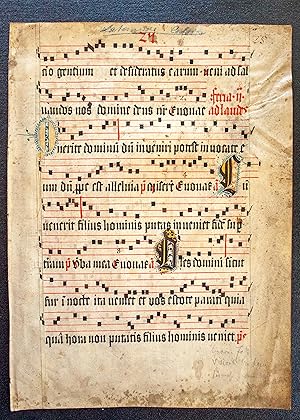
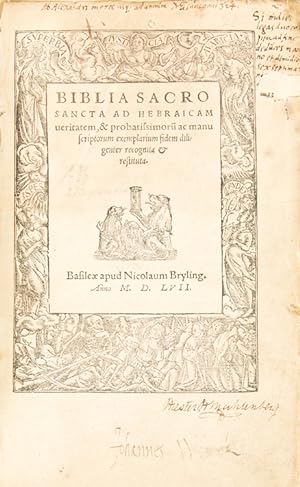
![Bild des Verkäufers für Biblia Sacra utriusque Testamenti, iuxta Hebraicam et Graecam ueritatem, uetustissimorumq[ue] ac emendatissimorum codicum fidem diligentissime recognita zum Verkauf von James Cummins Bookseller, ABAA](https://pictures.abebooks.com/inventory/md/md30922136259.jpg)

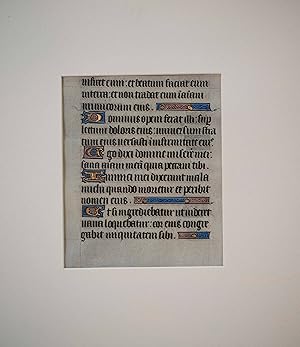
![Bild des Verkäufers für Biblia sacra [the Gutenberg Bible]. zum Verkauf von Rodger Friedman Rare Book Studio, ABAA](https://pictures.abebooks.com/inventory/md/md30968534461.jpg)
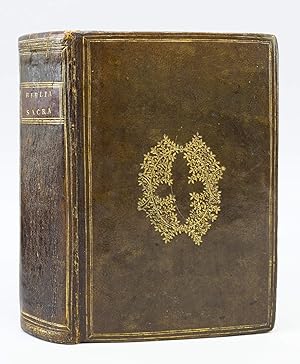

![Bild des Verkäufers für Biblia Sacra vulgatae editionis Sixti Quinti Pont. Max. jussu recognita atque edita.Including: Novum Jesu Christi Testamentum, vulgatae editiones, Sixti V. Pont, Max jussu recognitum atque edititum.Antwerp, "Officina Plantiniana" [= Balthasar I Moretus, grandson of Christoffel Plantin], 1629. 7 volumes bound as 9 (Old Testament I-VII & New Testament I-II). 24mo in 8s (11.5 x 7 cm). With a richly engraved general title-page, 6 volume title-pages (each with the same Plantin-Moretus woodcut compasses device), a smaller woodcut compasses device plus 3 (of 4) repeats (2 appear on the back of the colophon; each of the others on an otherwise blank leaf), woodcut tailpieces, woodcut decorated initials. Set in roman and italic types. The present copy with 3 extra letterpress divisional title-pages, perhaps specially printed for this copy when it was bound. Uniform gold-tooled goatskin morocco (ca. 1700), sewn on 4 supports, richly gold-tooled spines, gold-tooled turn-ins and board edges. Seven zum Verkauf von Antiquariaat FORUM BV](https://pictures.abebooks.com/inventory/md/md30507606832.jpg)
![Bild des Verkäufers für [Biblia Latina] Numbers 21-23 zum Verkauf von Heritage Book Shop, ABAA](https://pictures.abebooks.com/inventory/md/md31426791038.jpg)
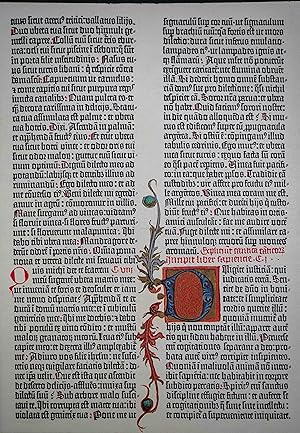
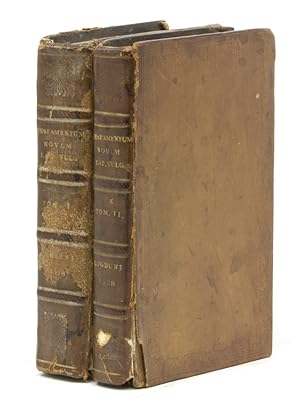
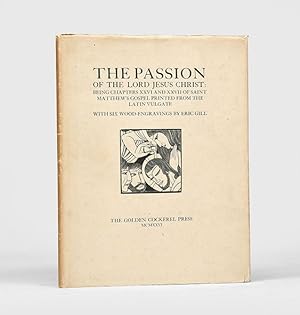
![Bild des Verkäufers für Novum Jesu Christi Testamentum.Antwerp, Christoffel Plantin, 1564[-1565].With: (2) [INDEX]. Hebraea, Chaldaea, Graeca, et Latina nomina virorum, mulierum, populorum, idolorum, urbium, fluviorum, montiu[m], caeterorumq.; locorum quae in Bebliis sparsa leguntur . cum Latina interpretatione: additis etiam Bibliorum locis in quibus ita scripta legu[n]tur: qua in re interpretationem quae in Bibliis Compluti excusis erat .Antwerp, Christoffel Plantin, 1565. With Hebrew and Greek types.2 works in 1 volume, the 1st in 2 parts. 16mo (11.2 x 7.2 cm). Contemporary blind- and gold-tooled calf. zum Verkauf von ASHER Rare Books](https://pictures.abebooks.com/inventory/md/md31069559141.jpg)
![Bild des Verkäufers für Biblia Sacra. [vol I (of VII)] juxta vulgatam editionem ad vetustissima exemplaria castigata. zum Verkauf von Blackwell's Rare Books ABA ILAB BA](https://pictures.abebooks.com/inventory/md/md31305255942.jpg)

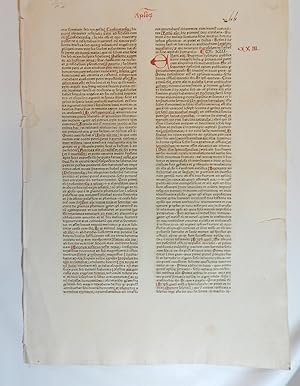
![Bild des Verkäufers für [BIBLIA SACRA] zum Verkauf von Phillip J. Pirages Rare Books (ABAA)](https://pictures.abebooks.com/inventory/md/md31620189724.jpg)
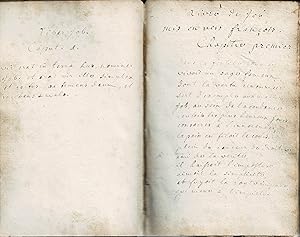
![Bild des Verkäufers für Testamentum Novum, ex Des[iderii] Erasmi Rot[erodamiensis] versione, ac ejusdem recognitione postrema [A VERY SCARCE EDITION, ADORNED WITH COPIOUS ANNOTIONS] zum Verkauf von ERIC CHAIM KLINE, BOOKSELLER (ABAA ILAB)](https://pictures.abebooks.com/inventory/md/md31372646300.jpg)
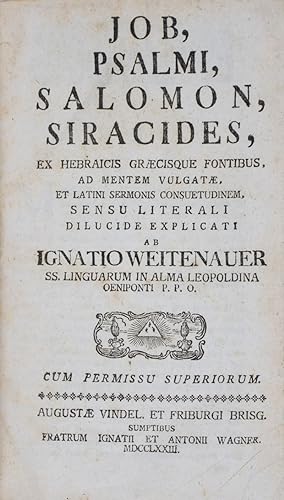
![Bild des Verkäufers für Liber Jobi cum nova versione ad Hebraeum fontem et commentario perpetuo. Tomus Primus [-Tomus Secundus] (The Book of Job Newly Translated from the Hebrew with a Running Commentary) zum Verkauf von ERIC CHAIM KLINE, BOOKSELLER (ABAA ILAB)](https://pictures.abebooks.com/inventory/md/md31201503199.jpg)
